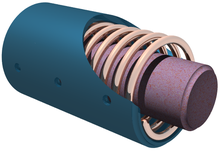Exciting news about Magnetoelectric chips
A team led by researchers at the University of Michigan has developed a material at least twice as "magnetostrictive" and much less expensive than other materials in its class. This material could also lead to better magnetic sensors for medical and security devices and a power for a new generation of more efficient computing devices.
There is a possibility that the property called Magnetostriction, which causes the noise of fluorescent lights and transformers, can power a new generation of more efficient computing devices that store data with magnetic fields, rather than electricity.
Magnetostriction occurs when the shape of a material and the magnetic field are linked - that is, a change in shape causes a change in the magnetic field. This property could give rise to new generations of computing devices called magnetoelectrics.
Magnetoelectric chips could make everything from massive data centers to mobile phones much more energy efficient, reducing the electricity requirements of the world's computing infrastructure. They use a fraction of the energy because they do not require a constant flow of electricity as current chips do.
Made of a combination of iron and gallium, the material is detailed in a paper published in Nature Communication. The team is led by U-M materials science and engineering professor John Heron and includes researchers from Intel; Cornell University; University of California, Berkeley; University of Wisconsin; Purdue University and elsewhere.
Typically, the magnetostriction of the iron-gallium alloy increases as more gallium is added. But these increases level out and eventually begin to decrease as larger amounts of gallium begin to form an ordered atomic structure.
The magnetoelectric devices made in the study have a size of a few microns - large according to calculation standards. But researchers are working with Intel to find ways to reduce them to a more useful size that is compatible with the MESO program. While a device that uses the material is probably decades away, Heron's lab has applied for patent protection through the U-M Office of Technology Transfer.
Image from en.wikipedia.org

